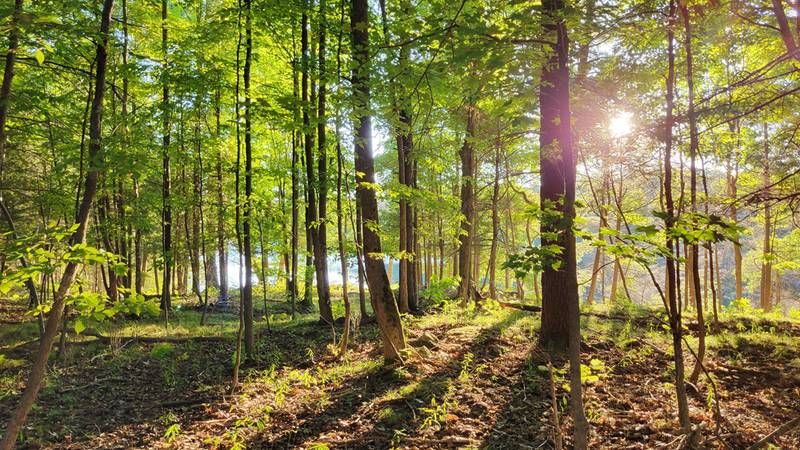Submitted by the Nature Conservancy of Canada | Mar 06, 2024
Two new nature reserves were announced by the Nature Conservancy of Canada (NCC) on the occasion of World Wildlife Day this past Sunday (March 3)
111 hectares that are now permanently protected are within a vast natural corridor that supports the survival and resiliency of many plants and animals. By expanding on the existing network of lands conserved by NCC and conservation partners, these projects help wildlife in the area have more space to feed, nest, breed, move and thrive.
The nature reserves are each located next to existing conservation lands.
Blue Lake nature reserve, adjacent to the Gould Lake Conservation Area and near Frontenac Provincial Park, is a picturesque 35-hectare site with over 1.4 kilometres of shoreline on Gould and Blue lakes. It features intact deciduous forests, wetlands and the pristine Blue Lake, creating a rich mosaic of habitats that support at-risk species like cerulean warbler, several species of snake and turtle, and more. The property’s wetlands provide excellent conditions for beaver and waterfowl, such as great blue heron, wood duck, common loon, hooded and common merganser and others.
Meanwhile, NCC’s Hawkridge Nature Reserve, near Elgin, in the Township of Rideau Lakes, has been expanded through the protection of an additional 76 hectares immediately north of the property. The newly conserved section contains forests, marsh and Provincially Significant Wetlands teeming with waterfowl and other birds, turtles and amphibians, such as eastern wood-pewee and eastern musk turtle. An active and isolated “heronry” is also on site, meaning that heron pairs are breeding, nesting and rearing young within the site’s rich aquatic habitats.
Elgin is in the Township of Rideau Lakes on Hwy. 15
The high-quality forest, lake and wetland habitats of the Frontenac Arch region, with connectivity to the surrounding forest matrix and protected areas, are part of an important north-south linkage in eastern North America called the Algonquin to Adirondacks wildlife corridor. This unique area overlaps between the forests of the Canadian Shield and the southern Carolinian forests of the United States and fosters a diversity of plant, insect and animal species.
The Arch serves as a funnel for migrating birds, bats and insects, as well as animals with large home ranges, such as black bear, moose and eastern wolf. Habitat fragmentation poses the greatest threat to the Frontenac Arch; projects like Blue Lake and the Hawkridge expansion help protect large blocks of habitat, so that species that live there can continue to move and thrive.
These land purchases were made possible in part by the Government of Canada, through the Natural Heritage Conservation Program, part of Canada’s Nature Fund, the Government of Ontario, through the Greenlands Conservation Partnership Program. We thank the many private donors who supported these projects.
The expansion of protected lands at the Hawkridge and Blue Lake nature reserves showcases how NCC is accelerating the pace of conservation in Canada. In the face of rapid biodiversity loss and climate change, nature is our ally.
“By collaborating with partners like the Nature Conservancy of Canada, we are working to protect the Frontenac Arch region in Ontario. The conservation of forest and marsh habitats will expand a wildlife corridor while helping to protect species at risk and a Provincially Significant Wetland. As we prepare to celebrate World Wildlife Day on March 3, the Natural Heritage Conservation Program continues to protect essential habitats for wildlife across the country. This is one of the ways the Government of Canada is making progress toward its goal of conserving 30 percent of land and water in Canada by 2030.” – The Honourable Steven Guilbeault, Minister of Environment and Climate Change
Numerous species at risk are supported by these conservation projects, including cerulean warbler (endangered), gray ratsnake (threatened), eastern wood-pewee (special concern) and eastern musk turtle (special concern). Numerous turtle and bird species at risk, as well as plant species at risk, are also found on-site, such as black ash tree (threatened).
More Stories
- Two Way Race Shaping Up in Lanark-Frontenac Riding
- Line Spike, A Two Day Concert, Set For Canada Day Weekend In South Frontenac
- Driving Compassion: Community Champions Deliver More Than Meals
- Frontenac County inches towards Doctor Recruitment
- Addington Highlands Sets 2025 Budget – Tax Rate Up By 5.83%
- Official Plan Back Before South Frontenac Council
- Three King Charles III Coronation Award Winners from Frontenac County
- “Pickleball Lives in Piccadilly” – Frances Smith
- North Frontenac Council – March 14/25
- Refuseniks Voice Opposition to Ongoing Israeli Attacks on Gaza

